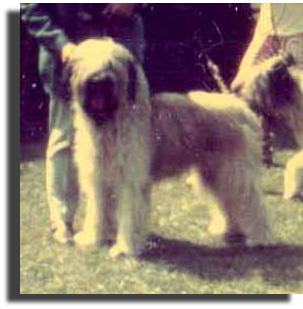
From Atlantic States Briard Club, Le Magazine:
How long have you been breeding Briards?
I have owned Briards since late 1965 and raised our first litter in 1980.
Did you have other breeds before Briards and do you have other breeds now?
Our family had a mixed breed, succession of Scotties and rescue dogs. Briards are the sole canine members of the current family.

What was the name of your first Briard and who was the breeder?
My first Briard was a rescue from the Atlanta Humane Society (Ollie). I was “hooked” on her personality and intelligence. However, the first “regularly” purchased Briard was Shayna Chez de Benederet from Dede Benederet in Michigan. Our natural ear, Shayna was out of CH.Ralph des Elfes de Moulouse CD and CH.Spooky Chez Chien Velu.
Are your Briards kept in your home or a kennel and why?
We own 21 Briards (18 of which we bred), 6 of whom live with us (Wolfi, Titch, Cou, Sailor, Rags, and Vivienne). They are all "house" dogs, occupying various areas: bedroom, office, pup room and wander about (but not all at once together). Briards, in our opinion, are not kennel dogs! Their open interaction among other dogs and people is necessary. However, seven large dogs all roaming around the same area can be a tripping hazard, and do get into mischief.
How many litters have you bred?
We have bred 9 litters (this includes 13 champions with more in progress) including one in England with our eldest daughter and family. I only breed when there is a specific "reason" to: improvement of the breed via selection of two specific Briards for the breeding pair. Briards from both the British and European lines are the foundation of our present line (1988, 1996(2) litters). The 1980 and 1983 litters were, at least, 2nd generation American.
Do you feel you have accomplished your goals?
In general, I am pleased with the results of our breedings. There is always room for improvement.

List in order of priority, what you look for in a Briard.
Temperament, movement/structure (meaning configuration, proportions, substance).
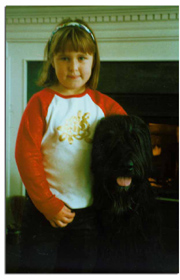
What did you set out to accomplish in your breeding program?
What we try to accomplish in our breeding program is intelligent, good-natured and typey, substantial shepherd dogs with quicksilver movement and the structure to provide it. The proportions should fit the description of the standard. Longevity in the line is definitely a factor in the breeding. The correct coat texture is desirable (which usually means more manageable although there can be exceptions). Each of our litters has had Briards suitable for future breeding and showing.
What is the most important quality you look for in a brood bitch?
Stud dog. There is no single attribute that can be stated. It is more as to which two dogs will compliment each other best. It is a question of what characteristics need to be enhanced or corrected by the mate. In addition, the background of the pedigree is an essential component -- sometimes even more so than the single animal involved. As many traits are polygenic, it is most important to know the genetic history behind each member of the pair.
What do you think of the three breeding methods: line breeding, in breeding, and outcrossing?
Our philosophy is that the brood bitch or stud dog compliment. What is important is a continuous progression of improved Briards. The “M” litters go back to Mme. Turgis’ Vasouy line on both the American (sire) and British (dams) sides. They are 5-7 generations behind the grandparents, and the M litter still has the “type” of these French dogs. On their sire’s side, the 11th generation is Kay Effel’s Gauche and Vivienne (her D litter was about 1950/USA).
Which of the three breeding methods do you use most often and why?
We have brought into the US what, in our opinion, are Briards from well-established (line bred) British and European lines that compliment our current gene pool. If we compare Ren and Pierre (my American line) as pups with Romeo (CH. Ecstasy Noir de la Maison du Garde-Barriere) and Cou (CH Ecoute-moi Chez Bailywick de la Maison du Garde-Barriere, CGC) Austrian born and out of Briards from France and Belgium;, they are four of the same type of rascals even though they are separated by 2 decades.


Who do you feel is the best Briard of your breeding and why?
CH. The Bailywick's Robespierre (Pierre) was the best proportioned and sized dog of our line. Pierre was a Rass "Excellent", had a gentle temperament and lived to 13.5 years. His littermate, The Bailywick's Renoir (Ren) was the most intelligent of our bitches. Bailywick's Uji from the 1983 litter had excellent substance, color and disposition. CH. Bailywick Mouton Noir d'Sagi (Noir) and his littermate Bailywick Mozart Carcer-Sagi (Wolfi) are beautifully proportioned dogs with excellent movement. In intellect, both of them have remarkable personalities and amazing vocabularies of any of the dogs we bred.

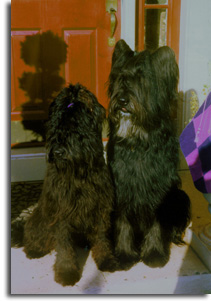
Who do you feel is the best Briard you have owned (not your own breeding) and why?
American born La Fraise Briard d’Orleans- Fresa (our charbonne brood bitch born in 1975) for the quality which she consistently produced (50% of her first litter were champions).


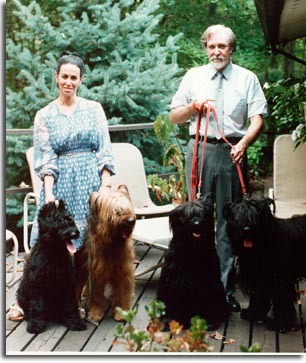
In your breeding program, was there one that "got away", that you wish you had kept?
Yes, Bailywick's Uji from the 1983 litter. He had excellent substance, color and disposition. It is unfortunate that we did not "collect" semen from him, as there is a need for his attributes currently.
What are some of the ways you socialize your puppies?
The pups are handled and exposed to a variety of stimuli (including music) frequently from early on. Friends (with responsible children) without dogs are invited to visit early and after the first shots, exposure to as many different size and types of people as possible is attempted. Car rides and walks in public are routine. Socialization with our vet and preliminary grooming (including nail trimming) is started early with lots of rewards.

Looking back, are there any change you wish you made in your breeding program?
Yes, I did not breed several of my exceptional Briards.
What are the strengths and weaknesses of your breeding program?
Structure, movement and profile/type are the strengths of our Briards. We need to watch size and tail carriage.
At what age do you evaluate your litters and what do you look for?
Normally, the litter is evaluated at 5 weeks of age for structure, after that time their bodies go off in different directions for at least 1 month. From 10 days on, we keep an eye on personalities. It is our belief that it is nearly impossible to define a “show” pup (in all aspects) prior to having it leave our home (8-9 weeks). It is easier to define “non-show” pups.
How would you describe a typical Briard of your breeding, physically and temperamentally?
We have bred very well proportioned canines with beautiful heads and the intellect to match. They have appropriate substance for their sex - you can tell the boys from the girls easily. They move like Briards should - reach and drive with appropriate side gait. Presently, we have a mélange of temperaments at home (some are territorial with respect to strangers), but all of the show dogs are well behaved in public.

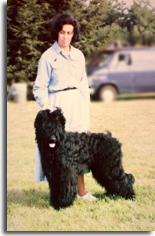
What was your biggest heartbreak in dogs?
Loosing Bailywick's Woofi in 1991 to a GI obstruction. We bred the English litter specifically for this wonderful dog and lost him at 2 1/2 years of age.
Do you have any advice for a beginning breeder?
Breeding Briards takes a great deal of commitment: knowledge of the breed and the lines, and time after the breeding. The latter applies not only to raising the pups, but, just as importantly, the responsibility of being there for the whole life of each of the pups. As a breeder, it is necessary to follow-up with first time Briard owners continually. What is common knowledge for those of us with Briards is new and unexpected to many. This, unfortunately, can lead to heart-breaking situations. At some point, a breeder has to recognize when to ask for a dog back and be willing and able to retrain or re-home it. This is an uncommon breed and not everyone should own a Briard.In addition, it is important to choose the correct breeding partner. Strange as it may sound, this will have a significant impact on the future of your efforts.
What was your most memorable show win?
Our most memorable show wins were: Noir's (CH. Bailywick Mouton Noi d'Sagi) first major (as it was my first major, too) -- Vincent Clemente, judge. He just showed his heart out for me. Cou's (CH. Ecoute-Moi Chez Bailywick de la Maison du Garde-Barriere) major at Morris & Essex under Roger Hartinger. The latter was very emotional as it was her wonderful handler's (Cheryl Cannon) first show after major surgery and Cou was entered -- mainly to support the ASBC entry.
Which Briards do you feel have made the most impact on the breed?
Briards that have made the most impact on well-being and beauty of our breed have been numerous on both sides of the Atlantic. For example, Eng. CH. Carcer Nuit St. George. George won the breed at Crufts in 1983 and was named Best Stud from 1982-1984. He and his sire teamed up as Best Briard Brace in 1980. Having sired and grand-sired several notable Crufts winners (out of 196 pups) and Champions, he was a dog to remember. Besides his physical attributes, he was a highly intelligent Briard, a wonderful family member and great friend. His beautiful movement and type descended into his progeny.

What is your favorite Briard story?
Some of our favorite Briard stories are: Rose teaching her son Wolfi to play “Opus” with me (not with her). Cou “faking” a puddle. Titch mutilating a toy and looking innocent. Romeo “allowing” his sister to take his beloved Nylabone- out of his mouth. Sailor rearranging his “Persian” rug for a nap. The household proving that child-proof catches are not Briard-proof.
What has made being a Briard breeder worthwhile?
Being a Briard breeder is the joy of sharing life with these exceptional canines, and the wonderful friends - both human and canine - that we have made via our Briardship.
